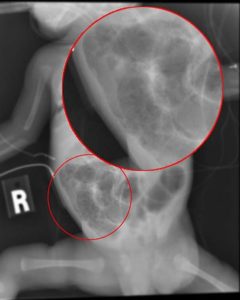The miracle of life is always a joy for parents and for everyone who is part of that moment. But despite all the happiness that comes with having a baby, there are some problems that may arise with it. And it’s important to talk about these things, even if it sounds unpleasant, because it’s necessary to be prepared to deal with such situations and to learn that not everything will always go right at birth—but that doesn’t mean many things can’t be solved either. This is the case with neonatal necrotizing enterocolitis which, despite its frightening name, is one of the most common diseases in newborn babies and has a treatment. The truth is that we all hope our babies will be born healthy and the only problems we have to deal with are those common to having a baby, but that’s not always possible, no matter how many precautions we take. Some things, unfortunately, are beyond our control and you need to be prepared to face this situation for yourself and, of course, for your baby. To better understand how to do this, we need to understand what this disease is, what its causes are, the symptoms, and what forms of treatment exist.
What is Neonatal Necrotizing Enterocolitis?
This is a lesion that occurs on the inner part of the intestine in newborns. More than 85% of cases occur in premature babies and in many cases also in babies who were born very underweight. This injury affecting the intestine can cause part of the organ to go into a state of necrosis and, consequently, spread further, causing inflammation of the peritoneum and intestinal perforation. Neonatal necrotizing enterocolitis is the most common type of gastrointestinal problem among babies in the neonatal period.
Causes of Neonatal Necrotizing Enterocolitis
The exact causes of this problem are not known, but there are some factors linked to all cases that may explain how this complication develops. First, poor blood supply to the intestine, which can lead to problems, allowing bacteria to enter and produce a type of gas that perforates the intestinal wall and ends up causing part of the intestine to become necrotic. In addition to premature babies, other risk factors for neonatal necrotizing enterocolitis include birth asphyxia, prolonged rupture of the amniotic sac, and the baby being very small at birth.
What Are the Main Symptoms?
Children with neonatal necrotizing enterocolitis have great difficulty feeding, with frequent vomiting that may contain biliary juice (greenish in color) after feeding, and blood in the stool. In addition, the child’s abdomen tends to be distended. Sepsis, a type of inflammation resulting from chemicals released by the body itself, may cause the baby’s blood to become more acidic and trigger bouts of apnea and hypothermia.
Diagnosis of Neonatal Necrotizing Enterocolitis
The diagnosis of the disease is based on observation of symptoms and also on certain tests, primarily an X-ray, which can show gas in the infant’s intestine or even whether the intestinal wall has already been perforated. In addition, an ultrasound and blood tests will also help detect signs of this problem. The doctor will check if the symptoms such as vomiting and blood in the baby’s stool are related to neonatal necrotizing enterocolitis and, along with the tests, provide the diagnosis of whether or not it is the disease. The diagnosis is usually given quickly, and treatments begin as soon as this complication is confirmed, so the baby suffers as little damage as possible. 
Treatment of Neonatal Necrotizing Enterocolitis
The first step in treating neonatal necrotizing enterocolitis is to stop feeding and to insert a suction tube in the baby, which is used to administer medications (especially antibiotics used to treat this condition), relieve pressure, and keep the baby hydrated. Some other very common forms of treatment are:
- Drains in the Abdominal Cavity
- Surgery
Let’s briefly talk about each of them and how they can help in the treatment of neonatal necrotizing enterocolitis.
Drains in the Abdominal Cavity
Drains are used so waste can be removed from the intestine and can help stabilize the newborn for possible surgery. They are typically used when the baby is very small and doctors believe the child would not survive surgery.
Surgery
Surgery is necessary in 25% of cases of neonatal necrotizing enterocolitis and is only performed when doctors believe there is no other option, when the gangrenous intestine cannot be recovered and removal needs to be done. It is a complicated and delicate surgery, especially because it involves such small babies. The mortality rate for this complication is 20% to 30%, but surgical intervention can have a positive effect and increase the baby’s chances of survival. Although it’s not always possible to control every condition related to your baby’s birth, you can prevent many other types of disease. The best weapon for this is prevention, starting with prenatal care and continuing throughout the child’s childhood, with proper vaccinations and taking all necessary precautions to ensure nothing too serious happens. Of course, it’s normal for a baby to get sick from time to time, and sometimes there’s simply nothing we can do to prevent these illnesses. In those cases, the best thing to do is to visit a doctor and strictly follow all their recommendations so you can protect your child as best as possible. Your baby getting sick does not mean you are not taking good care of them, but they will need a lot of your care to recover. See Also: Neonatal Abstinence Syndrome Photo: RadsWiki











